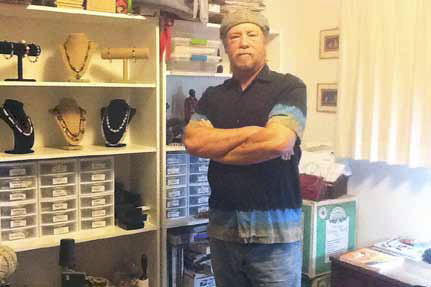By Daniel Rothberg, The Nevada Independent
During a speech for the Western Governors Association on Monday, Gov. Brian Sandoval called invasive species “one of the most persistent, challenging environmental issues in the West.”
Sandoval, a former chair of the association, opened a two-day workshop focused on combating non-native species that transform ecosystems and threaten habitat in lakes and on the range across the West. The workshop is part of the association’s initiative to study an issue that can have potentially negative consequences for the environment, agriculture, tourism and fighting wildfires.
“The impacts of invasive species in the West are as pervasive as they are underreported,” said Jim Ogsbury, the association’s executive director. “Agriculture. Forestry. Tourism. All of these industries are struggling to eradicate and mitigate the insidious impacts of these species.”
Within walking distance of Lake Tahoe, the workshop was focused on aquatic invasive species, a huge problem for Lake Tahoe and Lake Mead. Yet after two massive wildfires in Nevada this summer, several speakers brought up problems around cheatgrass, a highly-flammable and durable invasive weed that fuels more extreme blazes and grows back in scorched land.
“Just recently, we had the largest fire in Nevada history, almost half-a-million acres. That’s 686 square-miles, almost half the size of Rhode Island,” Sandoval said. “The fire was not only fueled partly by invasive cheatgrass, but it will now be an area where invasives flourish.”
The Martin Fire, which ripped through dry vegetation outside Winnemucca in the morning hours after July 4th, devastated grazing allotments and habitat for the Greater sage-grouse, an imperiled bird that Sandoval, industry and environmental groups have been working to manage collaboratively. Their goal is to keep the bird from being listed under the Endangered Species Act. A listing could slow, if not halt, development across the West and hurt local economies.
Other invasive species push out native species by out-competing for water or land, a change to an ecosystem that can have major ripple effects. Land managers at Lake Mead, the Colorado River reservoir impounded by the Hoover Dam, routinely deal with invasive Zebra and Quagga mussels, which clog motorboat engines and pose a threat to the ecosystem.
And as with cheatgrass, they spread rapidly. To make that point at the workshop, Laura Megill, the aquatic invasive species coordinator at the Nevada Department of Wildlife, held up a glass case with a shoe in it. The shoe, left in Lake Mead for 12 months, was encrusted with mussels.
Megill said it was a demonstration of how quickly and how entirely invasive Zebra or Quagga mussels, the tiny shells on the shoe, will overtake an object. For her, the shoe underlines the importance of cleaning and inspecting boats to avoid spreading invasive species to other lakes.
Right now, the goal is to keep these mussels out of the Lake Tahoe Basin.
“I can’t think of a more fitting place to begin this conversation than Lake Tahoe,” Sandoval said during remarks at the MontBleu Resort in Stateline. “Every day, Lake Tahoe is threatened by aquatic invasive species, which can cloud the lake’s famous clear blue waters.”
The governor highlighted some of the state’s efforts in eradicating invasive crayfish, and he noted that other organizations at the lake have paid divers to pull out invasive plants.
In recent years, biologists have made progress curbing the introduction of new invasive species in Tahoe. At last month’s Tahoe Summit, an annual bi-state forum, lawmakers highlighted the fact that no new invasive species have been introduced there since a boat inspection program went into place 10 years ago, though existing invasive species remain an issue.
Sandoval said the association’s initiative, which focuses on an issue that normally gets very little attention, is timely. Monday’s workshop was the first of several that the association plans to hold this year. In the next three months, it will host workshops in Wyoming, Montana and Hawaii.
“The collaboration we see at Lake Tahoe is possible because the control and management of invasive species is truly a bipartisan issue,” Sandoval said, noting the federal government’s role in the issue. “These invaders ignore all boundaries, borders and political parties.”
The U.S. government, which controls almost half the land in the West and more than 80 percent of the land in Nevada, has a significant amount of leverage in how land is managed. This fact is particularly true when it comes to wildfires and cheatgrass. After his speech Monday, Sandoval told reporters that he would like to see the federal government focus more on preventing fires.
“We shouldn’t just be spending all of our money on fighting fires,” Sandoval said. “We should be spending our money on preventing fires. And a big piece of that is working on removing invasive species and when there is a wildfire, [planting] the seeds for native grasses instead of allowing that cheatgrass to come in because again, it makes a bad problem worse.”
Ranchers have called on the Bureau of Land Management, the agency that controls most of their land, to allow more grazing on public land as a way to thin out fields of cheatgrass. The BLM has started several pilot projects to make its grazing rules more flexible, though projects have faced criticism from some environmental groups opposed to grazing on public land.
Sandoval said he supports the agency’s efforts.
“If there are ways to do that — to let our rancher’s expand their grazing opportunities — I think that is a good thing,” Sandoval said. “To have our ranchers join as partners on fighting these wildfires — that’s a way they make a living — that could be very beneficial.”
This article was reprinted with permission from TheNevadaIndependent.com


